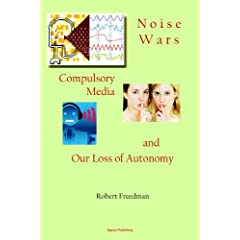New book rails against digital signage, digital out of home networks
August 21, 2009 by Dave Haynes

You can buy a book available on Amazon now that takes a look at our emerging media sector and rails against it, likening the values war over the screens that are going up on anything from gas pump tops to golf bags to the fight over second-hand smoke.
Called Noise Wars: Compulsory Media and Our Loss of Autonomy, the book says digital signage networks intrude on lives and take away the freedom offered by TV and radio just to turn the things off. “As a result, many people are resisting being made captive to content that’s pushed out to them against their choice.”
Author Robert Freedman is described as a 25-year veteran business journalist with a master’s degree in Humanities from Marymount University, with previous books on virtual reality in marketing and consequential reporting in business-to-business journalism.
From the press release I got via email:
The book, by a communications professional who took notice of captive-audience media when a transit agency released plans to install TVs on subway trains and buses, doesn’t challenge media companies’ right to introduce captive-audience media to public and private settings such as subways, buses, trains, elevators, taxis, street corners, gas pumps, bus stops, public restrooms, office lobbies, doctor’s offices, coin laundries, classrooms, school buses, and restaurants, among other places. Rather, it calls into question the wisdom of building a business model around an information delivery system that makes many people angry and resentful.
“The minute I see TV at a checkout, I tell the manager, ‘Watch me. I’m about to walk out of your store because I can’t stand TV,” one person says in the book. “You won’t see me again until all the other stores in the area have the same damn thing and I must put up with it or starve.’ No, no, don’t try to tell me how most people seem to like it. I’m not most people, I hate it, and I’m leaving now, empty-handed.”
The author cites example after example of consumers reacting with hostility to the introduction of out-of-home TV and other intrusive media in settings where they can escape only at high personal cost.
“I will not go to stations that have TVs on gas pumps. So, as a result, I have not been to my neighborhood gas station in months. I can only hope other people are doing the same thing. If not, this sort of irritating constant sales bombardment will start going on everywhere.”
“I serve notice to all those who force me to see their ads by interfering with my elective reading. Never would I purchase your product. Cha-ching. That’s the sound of the cash drawer slamming on your fingers.”
The book talks about the difference between audio and video “push” media and traditional “pull” media such as print. With “pull” media, the audience decides when and where to consume content; with “push” media, the content pushes out to people whether they want to consume it or not, creating a suffocating environment for those who are unwilling to be taken captive.
Algora Publishing is a NYC-based publisher focusing on non-fiction, left-leaning books about social injustice. I must admit I poked around a bit just in case someone was pulling my leg, but this appears to be a real book. I was skeptical not because I don’t think there are people out there who dislike DS networks, but more that I wasn’t convinced the footprint was big enough for anyone to notice amd actually produce and publish a book.
I had to take media training from a PR firm 10 years ago so I could properly field questions about the invasiveness of screens in elevators, so the fuss is not new. I’ve just never seen it quite so organized.
I doubt we will see even a hint of a real debate or values war that could be likened to what went on and what happened with cigarette smoke. That stuff will kill you. At most, this may irritate you.
It would be easy to dismiss the author and his sentiments as isolated and a little extreme. But there is a real message in here about content and strategy. One of the reasons people like Freedman don’t like some of these networks is that they offer no value in terms of the programming, and that programming is out of context with the environment or setting. The now-dead screens on commuter trains in my city offered ads and old TV news, and absolutely nothing about the basics, like which stop we were approaching or service disruptions. That really was just visual noise, and I can fully understand how people could grow to dislike those things. Meanwhile, the screens on the platforms of the Toronto subway system that people jump on right after they get off the trains, tell me about services, show interesting and very different content, and let me know when the next damn train is coming. It has value.
The book is $22.95, has 220 pages, is sold on Amazon. Just heard about it. Haven’t read it. The cover looks like it was designed by someone right after he finished his 5th grade science project. Eeesh.





Leave a comment